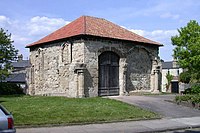Barnwell, Cambridgeshire
| Barnwell | |
|---|---|
 The Cellarer's Chequer, Barnwell Priory. |
|
| Barnwell shown within Cambridgeshire | |
| Population | 1,967 (Ward. 2011) |
| OS grid reference | TL479584 |
| District | |
| Shire county | |
| Region | |
| Country | England |
| Sovereign state | United Kingdom |
| Post town | CAMBRIDGE |
| Postcode district | CB5 |
| Dialling code | 01223 |
| Police | Cambridgeshire |
| Fire | Cambridgeshire |
| Ambulance | East of England |
| EU Parliament | East of England |
| UK Parliament | |
Barnwell is a suburb of Cambridge in England. The population of the Barnwell ward of Cambridge City Council at the 2011 Census was 1,967. It lies northeast of the city, with Cambridge Airport located immediately to the east. It forms part of the ecclesiastical parish of St Andrew the Less and was the site of Barnwell Priory.
Barnwell is also home to the Leper Chapel near the Newmarket Road bridge over the railway at Barnwell Junction. Built in 1125 the chapel is one of the oldest buildings in Cambridge.
The history of Barnwell effectively began with the creation of the house of Canons Regular in 1092 by Picot, Lord of Bourn and Madingley and sheriff of Cambridgeshire at the time of the Domesday Book. The house was originally near Cambridge Castle but moved to Barnwell in around 1119 and became Barnwell Priory.
By the 14th century the city of Cambridge was divided into seven wards, of which the smallest was Barnwell Ward, believed to cover the few houses along the Newmarket Road that fell outside the city's Barnwell Gate. In 1835 the city comprised five wards: East Barnwell, West Barnwell, Market, Trinity, and St. Andrew's, demonstrating the development in the area. Of the city's current fourteen wards, the Barnwell area is covered by the Abbey Ward, which itself takes its name from Barnwell Priory.
By the mid-19th century, Barnwell was a rough area inhabited predominantly by railway workers and manual labourers such as those mining fossil beds. Ion Keith-Falconer opened a mission in a local theatre in 1875 in an attempt to reduce poverty in the area. The astronomer William Scott also worked in the slums in the 1850s as a curate.
...
Wikipedia

